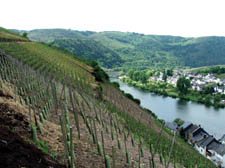|
|
 |
| |

A steep vineyard overlooking the Moselle River in Germany |
Rediscover the wines of Germany
After years of neglect are German wines on their way back to British tables?
ONE omission from our discussion two weeks ago of the effects of hot summers on alcohol consumption was German wine. This was deliberate and today we’re addressing it.
We have just experienced the hottest July on record. Similar temperatures were promised for August that fortunately did not materialise. Nonetheless, global warming means that hot summers are more likely to be the rule than the exception in future.
This makes German wines interesting, if only because their alcohol levels range from around eight to 12.5 per cent. By prevailing standards this is low, less alcohol meaning less dehydration.
Most of us associate German wine with light, clean, crisp Mosel, sweeter Rhine wines and the widespread use of the riesling grape. We should note that the riesling’s legendary versatility gives different results in different regions.
According to market research, Blue Nun remains the best-known brand of wine in Britain. Yet, until recently, sales of German wine declined for almost a generation.
This was partly due to the reputation of German wines, in the words of Armin Diel and Joel Payne, as “cheap, sweet and for elderly people” (summoning up a surreal mental image of drunken parties in a geriatric care home).
Diel and Payne are the authors of the Gault Millau Guide to German Wines, the most authoritative source of which we are aware, published in English for a second time last year (Mitchell Beazley, £16.99).
In contrast to English wine writing, which tends to be a mixture of travelogue and recommended vintages, this is as much a trade publication as meant for the general public. It covers over 800 producers and nearly 7,000 individual wines.
This workmanlike straightforward approach also applies to many of the wines described.
For immediate neighbours, French and German wines could hardly be in greater contrast. The exception is Alsace with its chequered history, combining features of both. The differences are between the complexity of French wines and the simple elegance of their German counterparts.
The popularity of German wines suffered not simply from their sweetness but came close to collapse with the 1985 Austrian glycol contamination scandal, which also implicated a number of German producers. This was a classic marketing failure and German wines have taken nearly twenty years to recover.
One problem for English wine drinkers is how to choose from the growing range available.
We make a broad division into three ‘classes’. This may seem fairly basic and doesn’t fit every wine in Germany. But we hope it’s a reasonable rule of thumb.
First, there are the supermarkets’ lower shelf budget wines, starting with Tesco’s ‘everyday lower price Hock’ at £1.98 (nine per cent). Blue Nun Qualitätswein, now revamped, is £3.39 (10 per cent). Not quite 50p more at £3.83 is its stable mate, Blue Nun Original Riesling (11.5 per cent).
Above this ‘bargain basement’ category, there are a dozen firms, producing between them almost 850 million bottles with a strong export presence throughout Europe, the USA and increasingly eastern European countries and the Far East. The German Wine Institute argues that many German wines are particularly suitable to Indian and Oriental cuisine.
This leaves an interesting mix of smaller producers, who are the real force for diversity and interest in German wines.
Setting aside the budget category, therefore, anyone exploring German wines may follow two broad avenues. The first is the large producers. We recommend Reh-Kendermann, currently promoting a range of their wines throughout the supermarket sector, priced between £3.59 and £6.99 with a single wine (Dry Riesling BIB) at £16.99. They also include a red Dornfelder (£4.49, only from Tesco Extra).
The alternative is a small producer. We’ve chosen the wines of Dr Ernst Loosen, which also appear regularly in the supermarkets as a dedicated producer with a comparatively small output (around 70,000 bottles a year). His 2005 Villa Wolf Rosé de Pinot Noir (£6.95, only available in London from City Beverage Company, 303 Old Street) has crispness and balance we have found in no other rosé this year. |
 |
|
| |
 |
| |
| |
|
 |
|










